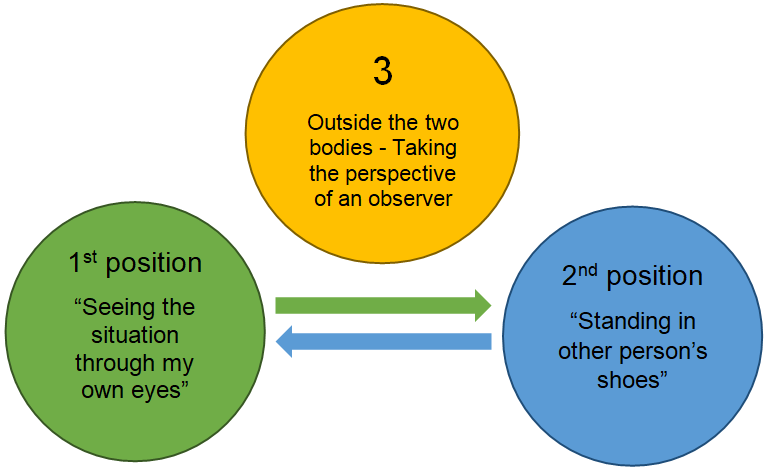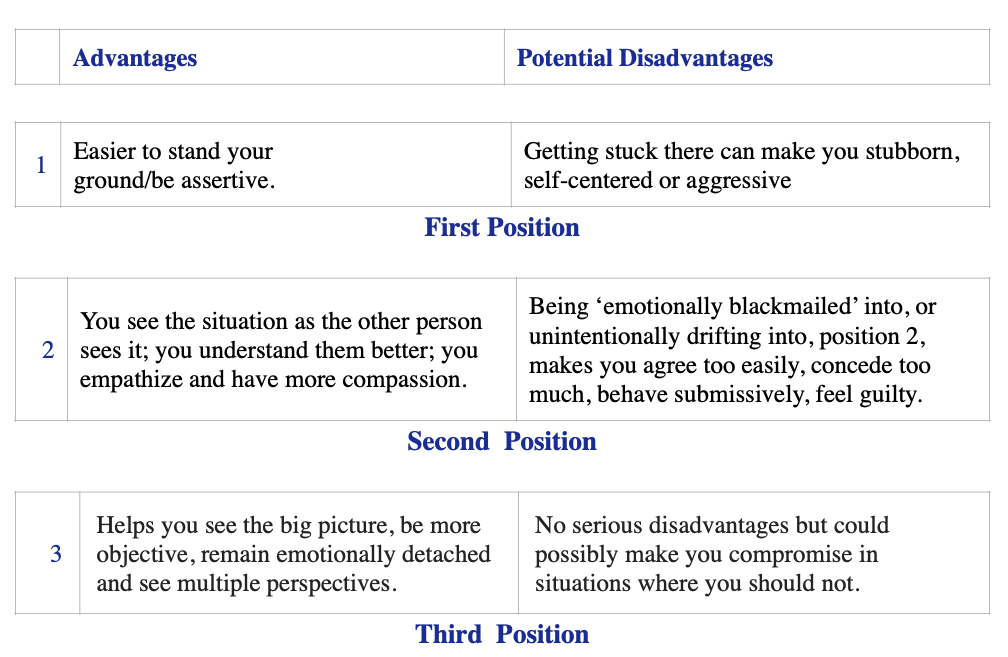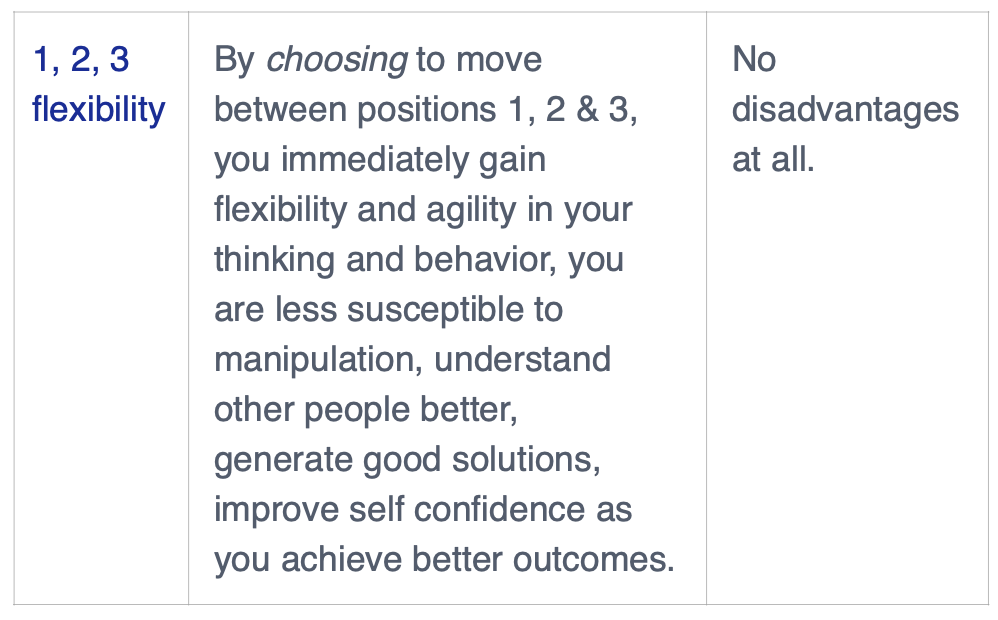
The ability to see things from the point of view of another is a key skill in understanding people, and is important to communication processes in relationships, negotiation and coaching, as well as to healthy boundaries and self-concept.
Often, it is useful to assess an event or outcome from several different perspectives: From our own perspective, from the perspective of another person and from the perspective of an independent observer.
Pioneering NLP developers, John Grinder and Judith DeLozier, refer to these perspectives as perceptual positions. Perceptual positions provide a balanced approach to thinking about an event or outcome. In situations where there is little or no understanding or progress, they can provide a way of developing new understandings and creating new choices.
Why perceptions differ
Everyone’s filter is a product of their experience – their culture, upbringing, events in their lives, etc. Your filter contains your attitudes, values, and beliefs. Some of these are similar to those of other people (for example, cultural norms) and some are specific to you (as you have had your own precise experiences).
Consequently, if two people are looking at the same thing, the deletion and distortion processes of their respective filters may give them two different perceptions. If, for example, two people look at the same glass of water, one might perceive it as half full while the other perceives it as half empty. It depends on their attitudes, values and beliefs. The amount of water in the glass is reality; but ‘half full’ or ‘half empty’ is perception.
However, very few people make the distinction between reality and perception. To them, their perception is reality and when people believe that their perception is reality, the consequences for effective communication can be negative.
Consequences for communication
Let us continue the map metaphor. Some maps are accurate and up to date, other maps are old and do not show new roads, bypasses, one-way systems, etc. Similarly, some people have a ‘mental map’ that is a reasonably accurate representation of reality while others have a mental map that is inaccurate and has not been updated since childhood.
Some maps are designed for a specific purpose such as motoring, hill walking or site-seeing. Similarly, some people have specifically personal representations of reality based, for example, on a career in the military, long-term unemployment, coping with a disability, being poor, being rich, etc. If you think of the people you know, your perception will be very similar to some people but very different from others.
In some situations the difference between your mental map and someone else’s mental map can be enough to make communicating with them extremely difficult.
You might have noticed that discussions about religion and politics often deteriorate into arguments. This is because these subjects frequently engender deep and rigid views of ‘reality’. So what the other person is saying is not filtered as just their opinion, it is filtered as ‘wrong’.
Using ‘perceptual positions’ to improve communication, relationships and self-confidence
By understanding and using the concept of perceptual positions, you can overcome many communication and relationship problems.
First, you accept that it is normal to see (perceive) things from our own viewpoint (position) and that may not be the way other people see them. This makes it easier and more natural to listen to, and understand other people. Your awareness that perception is not reality makes it easier for you to understand other people, communicate effectively with them and, consequently, to enjoy better relationships with them.
Second, in the same way you understand that a map is not actual terrain, you understand that perception is not actual reality. It might be a good representation of reality, a poor representation, an out-of-date representation or a specialist representation.
Most young parents with mortgages and careers, for example, will come to understand that the ‘reality’ they enjoyed as a carefree student has been overtaken by events and needs updating. Your awareness that perception needs updating makes it easier for you to grow and develop.
Third, you can develop thinking agility because, in any conversation between you and someone else there are not just two perceptual positions, there are three – how you see things (position 1), how the other person sees things (position 2) and how an independent, objective observer would see things (position 3).
Features of positions 1 and 2 are that people in them are emotionally attached to their own perceptions. This makes it more difficult to be objective, empathetic, and solution-orientated. Anyone in position 3, however, tends to have a more clear and rational view of the overall situation and has a reasonable view of how people in positions 1 and 2 see the situation.
This is another key point – each perceptual position has advantages and potential disadvantages.

You will have experienced all three perceptual positions, probably without realizing it at the time.
Any time you have stood your ground without compromise and expect others to see things the way you do, you have been in first position. Any time you have been emotionally blackmailed into agreeing with someone, you have been drawn into position 2. Any time you have listened to a friend complain about one of their colleagues and, because of your emotional detachment, you could see both sides of the argument and see a solution, you have been in position 3.
This is another important point – you can move between all three perceptual positions, but it is only when you do so deliberately that you get all the advantages and none of the disadvantages.

When you build rapport with people, you are in effect, second positioning them as you go into their world and take on their world view as well as your own.
Using ‘perceptual positions’ in practice
- You can stay in position 1, and not be emotionally blackmailed into position 2.
- You can move into position 2 deliberately and using probing to better understand the other person – not just what they want but, importantly, why they want it, what the situation looks like and feels like from their perspective. That leads to real understanding.
- When giving feedback, you can move into position 3 by chunking up.
- You can encourage the other person to understand your perceptual position by summarizing to demonstrate that you have listened to them and then framing your input appropriately – ‘So, if I have understood you correctly, let me explain my position’.
- You can encourage the other person to move into position 3 by: a) chunking up in your summary; b) asking questions that can only be answered from position 3 (for example, ‘When you present this proposal to the Board, what evidence will they look for?’) or c) pointing out a consequence (for example, ‘If we don’t allow the time necessary to include this information in the proposal, I believe the client will find fault in the whole proposal. I’d rather include it and give the proposal the maximum chance of success’).
The perceptual position concept has even more to offer.
How many times have you had an unsatisfactory conversation and then later you have replayed it in your mind and felt upset or angry?
How many times have you anticipated a forthcoming challenge (perhaps a presentation or a difficult conversation) and every time you thought about it you felt anxious or stressed? If you have had such experiences, you have been stuck in position 1.
Imagine the difference if you replayed the unsatisfactory conversation from position 3. You could ‘observe’ the conversation rationally, understanding all perspectives and work out how to handle it better next time. Imagine the difference if you ‘previewed’ the challenging event from position 3 and watched it unfold perfectly.
The easiest way of moving into position 3 in examples such as these is to pretend you are watching the situation on a screen (television, tablet, laptop, etc) and, every time the actor who looks like you behaves in a way that is less than effective, stop the video, rewind and replay the scene again as you want it to go. (It is your imagination so you can choose to imagine a positive scene.)
You can do more than tell the actor how to behave, you can also tell him or her how to think and feel. (Remember, how you think, feel and behave are all related; change one of them and the other two change automatically.) Do this as many times as necessary until the actor gets it right. You can then ‘morph’ into the screen so that now, instead of watching the scene from position 3, you are experiencing it from position 1. Replay it as many times as you like until it unfolds the way you want it to and you feel fine doing it.
Finally
You can get used to the perceptual positions concept by observing others in conversations and meetings, etc. You will probably notice how some people appear stubborn because they cannot see beyond position 1. Some people are too easily manipulated because they get drawn into position 2. Some people, however, are good at standing their ground and listening and being tolerant and being persuasive. They come across as positive, skilled communicators and quietly self-confident. They are usually the people with the thinking agility that the perceptual positions concept naturally engenders.
As you incorporate the perceptual positions concept into the way you think and behave, your communication skills will lead to better results. Those results will help you feel better in challenging situations. You will feel, and be more confident because how you think, feel and behave will be working together.
Responses
You must be logged in to post a comment.

Observing conversations is a great way to gain understanding of Perceptual Positioning. First Position where the person sees a situation through their own eyes; Second Position Ability to stand in a another person’s shoes; Third Position is outside of position 1 & 2 taking the perspective as the observer. The Observer position can in many instances see the point of view of position 1 & 2. Using Perceptual Positioning improves communications in relationships and negotiations. Gaining an understanding of how someone see things (point of view) provides a more reasonable response in any situation.